Car-Free Kea: A Cycladic Island Escape Near Athens
Just an hour from Athens, Kea...
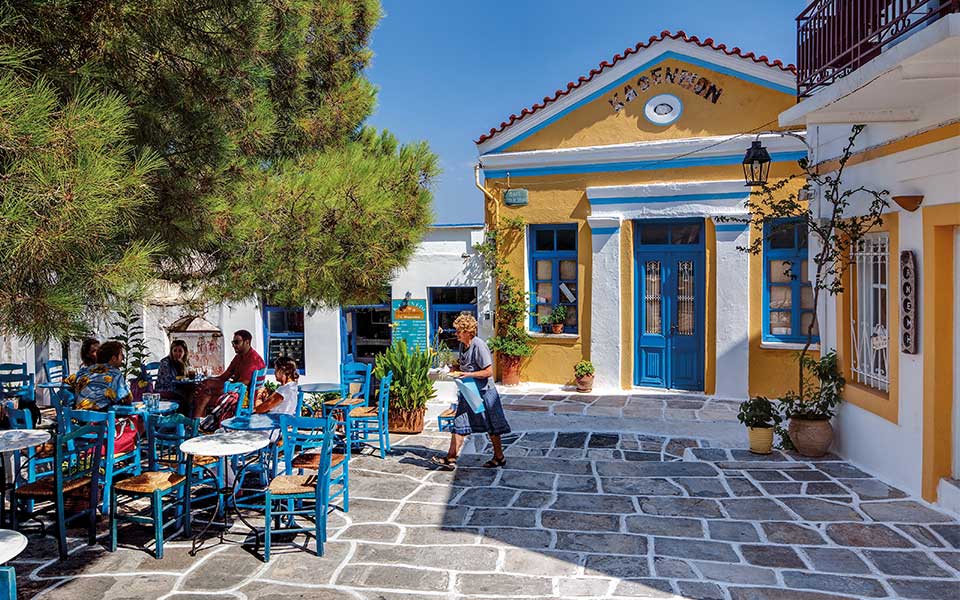
A traditional kafeneio on the small square in the village of Lefkes.
© Visualhellas.gr
Τhe sun was languidly rising as I made my way through the narrow lanes of Marpissa, the edges of the village’s white walls worn round by time. I moved under supple arches and over whitewashed pavements, and an unanticipated coolness swept my face, refreshing it.
Solitary bougainvilleas and other creeping and climbing plants splashed color onto the white canvas. Feeling woozy from the souma (a local spirit) that had kept us company all night and well into the early hours at Haroula’s taverna, I sought the trail that would take me to the summit of Kefalos and to Aghios Antonios, a twin-domed 17th-century monastery with a carved iconostasis dating from 1693.
I was bent on experiencing daybreak in the monastery courtyard. I didn’t exactly pull it off, but I did get there in time to catch the morning light bathing the sea and the meadows surrounding the village. The azure of the Aegean Sea spread out before me like a warm embrace. The island of Naxos, just opposite, was also waking up, in tandem with us.
I took a deep breath.
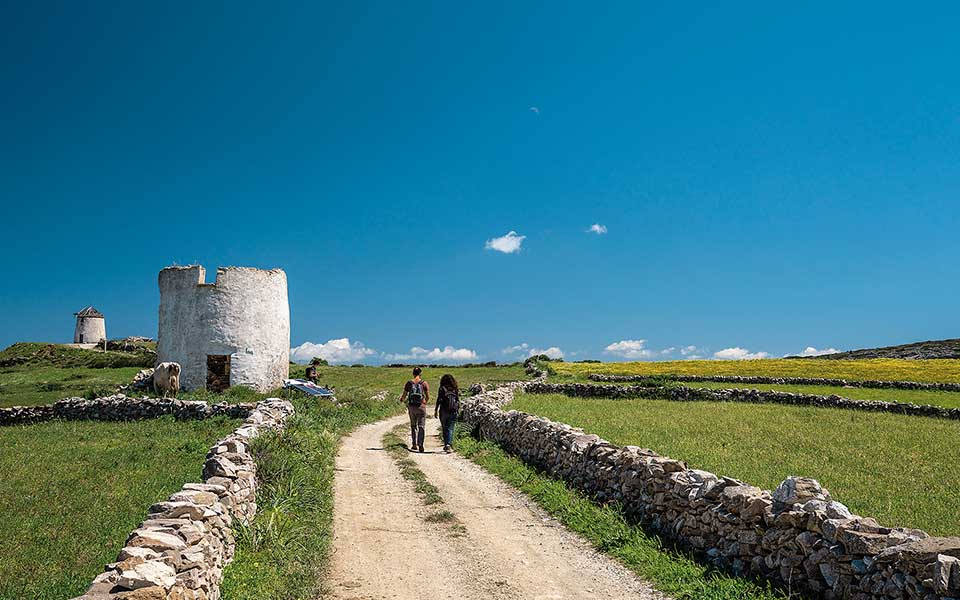
Hiking through the countryside on Paros.
© Nicholas Mastoras
For an instant, as I stood before the low, stone retaining wall, beneath a Greek flag that fluttered nobly, I was overcome by a sense of freedom. I unconsciously opened my arms, ready to fly to the golden sands of Molos. In the face of the impossible, I shut my eyes. I was transported back to 1537, to a time when Hayreddin Barbarossa, the admiral of the Ottoman fleet, used his forces to subjugate the Venetian leader Bernardo Sagredo and conquer Paros.
Isn’t this what happens with summertime desires, too? They rush in like a torrent, shattering any internal resistance. This place is an endless story, one passionately recounted to me by my friend, Markos, a local.
I stood there, encircled by the ruins of the Venetian castle, whose outer wall had been erected by Niccolo I Sommaripa, the onetime Venetian ruler of the island. In its shade grew fennel, oregano, sage and anemones. I could still taste Haroula’s fennel pie.
This is Paros – that is, everything that you cannot see at first glance. The visitor becomes seduced by the nightlife in Naoussa, dazzled by the cosmopolitanism of Parikia, gets trapped in its superficial beauties, but rarely follows its authentic light, which reveals the island’s secrets. This place deceives you and smiles.
Paros means nibbling on samphire pickled in local vinegar from the Kamarantho Active Organic Farm; enjoying a four-year-old PDO Malvasia from the Moraitis Winery, accompanied by local graviera cheese; skinny-dipping at Laggeri Beach at high noon, and then extinguishing your thirst with an ice-cold bottle of 56 Isles beer; leaving Tao’s after getting a therapeutic massage and then running with childlike abandon to Ambelas for a dip; or going for a swim at Filizi while your beach book awaits you in the shade of prickly cedar trees.
To put it another way, Paros is not being able to find the words you’re looking for in order to describe it to your family and friends.
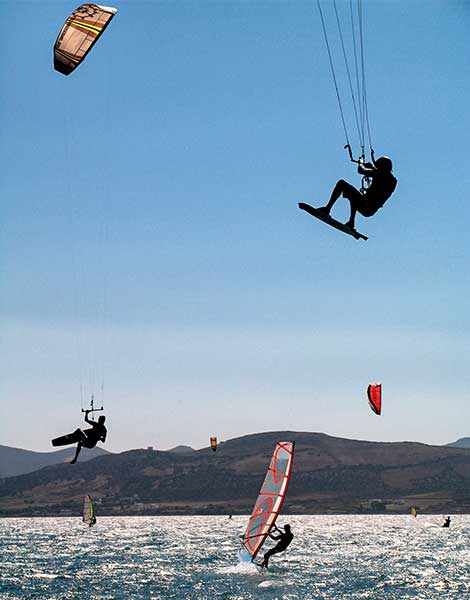
Windswept Pounda Beach is ideal for watersports.
© Shutterstock
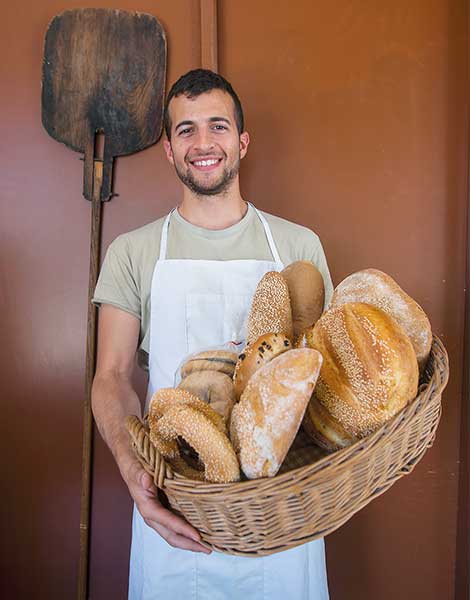
Stratis Kritikos at his bakery in Lefkes.
© Clairy Moustafellou
The Pueblos Blancos are a cluster of white highland villages located in Andalusia, Spain, isolated from the coastal holiday resorts – so what, exactly, does this have to do with Paros?
Well, Lefkes, Marmara, Prodromos, Marpissa and Kostos are snow-white villages situated on the eastern side of the island that have remained almost untouched by tourism; even in August, you won’t experience the packed-like-sardines situation so common in many areas.
In Lefkes – a unique village of master marble workers, which served as the first capital of Paros – be sure to drop in for an open-ended visit at Marigo’s kafeneio (traditional coffee house), with its tables fashioned from olive wood and its traditional chairs, across from Aghia Triada Church. Get some bread for your morning toast from Stratis’ bakery, in operation for over a century now; try some karavoli (large snails) with local garlic dip at Klarinou’s taverna, which stands proudly in the village square; and don’t forget to sample the island’s humbler products, too, such as the potatoes at the Aranto taverna, which they produce themselves and which are anything but “just potatoes.”
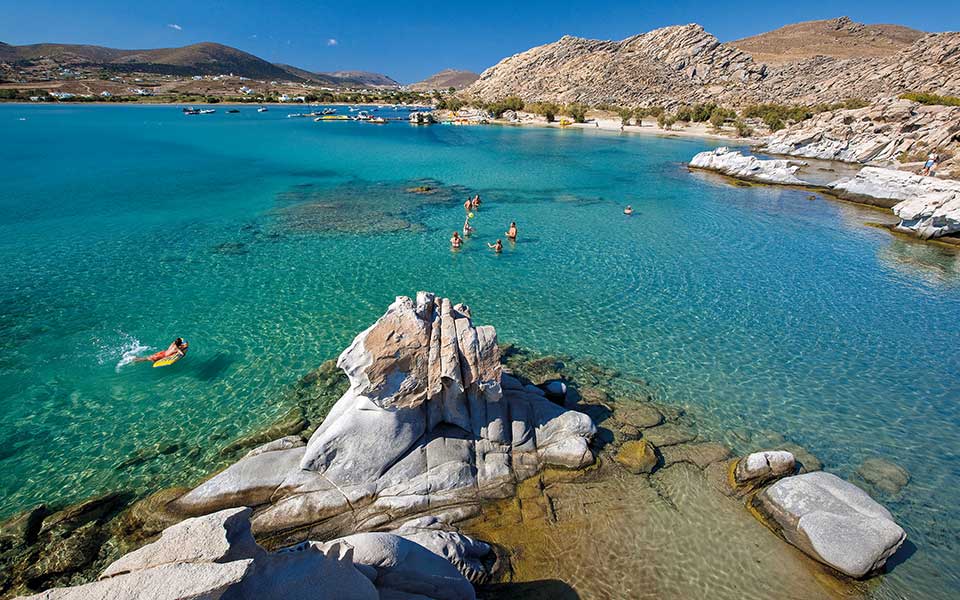
The famed Kolymbithres Beach on the island’s north coast.
© Visualhellas.gr
If you like walking and are in the mood for some exploring, take the Byzantine trail from Lefkes to Prodromos. This route is simply a dream; for an hour and a half, you wander along a thousand-year-old path, traversing age-old olive groves and vineyards.
Prodromos, your destination, was built as a fortified town; its walls protected its residents from pirate raids. Here, among tidy courtyards filled with geraniums and jasmine, you’ll find the Kallitechniko Kafeneio, the perfect place for a bite to eat, such as a midday revithada (baked chickpeas) or cooked octopus prepared by Maria.
In Marmara – a small farming village – be sure to light a candle at Pera Panaghia Church, with its icon of Panaghia Marmariani (Our Lady of Marmara), which dates to the 17th century.
The village of Kostos, meanwhile, is perfect for an evening stroll. You can imagine the nearby marble quarries, idle now for centuries, filled with workmen as they were in ancient times. The local marble – Parialithos (Parian stone) – was prized in antiquity and used for such world-famous sculptures as the Venus de Milo, the Winged Victory of Samothrace and Praxiteles’ Hermes and the Infant Dionysus.
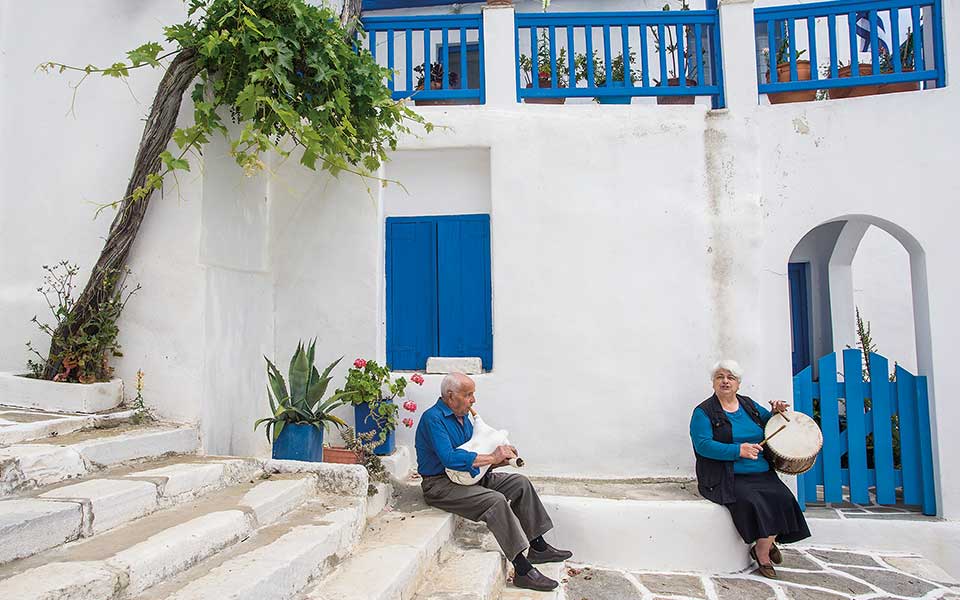
An impromptu recital featuring traditional instruments in Christos Square in Marpissa.
© Clairy Moustafellou
From the bay at Monastiri in the northeast – home to one of the most dazzling beaches on the island, one “blessed” daily by the Ai-Yiannis Detis Monastery – all the way down to Faragas Beach in the south, Paros boasts no soaring mountains. It’s as if the therapeutic Cycladic light were pushing the earth downward.
The island is strewn with walking trails, abandoned stone wine presses found right in the vineyards, and white crosses atop blue or white church domes. Other treasures include the captivating ancient cemetery near the port, in use from the 8th c. BC until the 3rd c. AD.
Whichever road you take from the interior, wherever the light may lead you, you’re certain to wind up at some beach with azure waters, the coastline’s great wealth offered freely.
I have a soft spot for Alyki, a fishing village in the southern part of the island. A mere dot on the map, it combines everything that summer means to me: hard-working kaikia (traditional fishing vessels) bringing back fresh fish; a humble pebble beach – Piso Alyki – with tamarisk trees providing natural shade, ideal for reading; and dinner at Saline – a stylish yet unpretentious seafood spot – seated on its atmospheric terrace with its refectory tables and white gazebo. There you’ll find fish soup made from rockfish, as well as exceptionally fresh shellfish, and white wine from Cycladic vineyards.
Alternatively, you can head out to sea. The fishing vessel “Rofos,” which belongs to Captain Ilias and sails from the port of Alyki, offers an excursion that drops anchor at fantastic places, including the small island of Panderonisi and the unforgettable Pirates’ Cave.
Every time I put on my mask in these waters, I really do feel as though I’m about to find some new treasure.
Just an hour from Athens, Kea...
This spring, five majestic peaks across...
Igor Borisov turned Kimolos into his...
A decades-old ritual, Sikinos’ ferry dives...